Practice Free AZ-204 Exam Online Questions
HOTSPOT
YOU need to reliably identify the delivery driver profile information.
How should you configure the system? To answer, select the appropriate options in the answer area.
NOTE Each correct selection is worth one point.
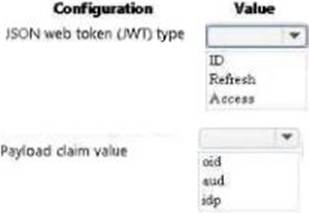
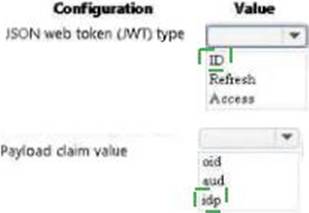
HOTSPOT
You need to resolve the Shipping web site error.
How should you configure the Azure Table Storage service? To answer, select the appropriate options in the answer area. NOTE: Each correct selection is worth one point.
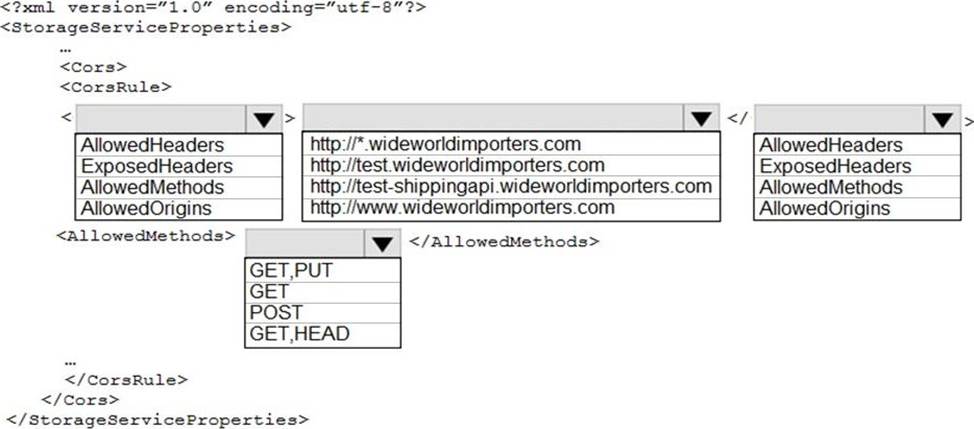
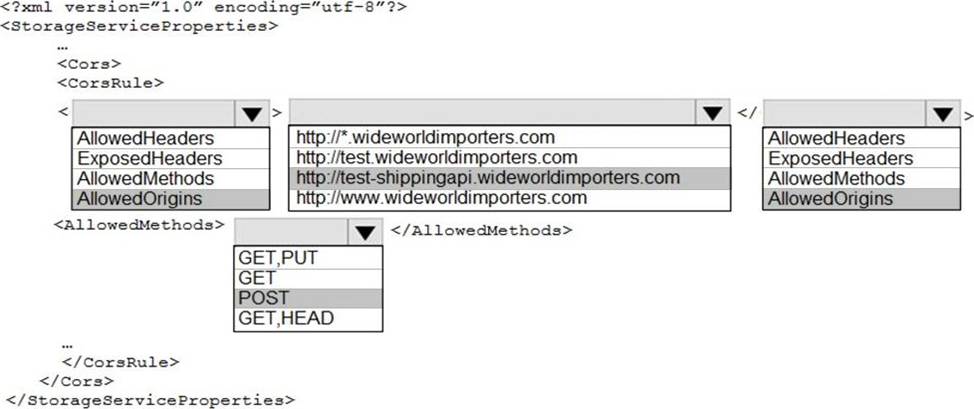
Explanation:
Box 1: AllowedOrigins
A CORS request will fail if Access-Control-Allow-Origin is missing. Scenario:
The following error message displays while you are testing the website:
![]()
Box 2: http://test-shippingapi.wideworldimporters.com
Syntax: Access-Control-Allow-Origin: *
Access-Control-Allow-Origin: <origin>
Access-Control-Allow-Origin: null
<origin> Specifies an origin. Only a single origin can be specified.
Box 3: AllowedOrigins
Box 4: POST
The only allowed methods are GET, HEAD, and POST. In this case POST is used.
"<Corsrule>" "allowedmethods" Failed to load no "Access-control-Origin" header is present
Reference: https://developer.mozilla.org/en-US/docs/Web/HTTP/Headers/Access-Control-Allow-Origin
HOTSPOT
You develop a news and blog content delivery app for Windows devices.
A notification must arrive on a user’s device when there is a new article available for them to view.
You need to implement push notifications.
How should you complete the code segment? To answer, select the appropriate options in the answer area. NOTE: Each correct selection is worth one point.
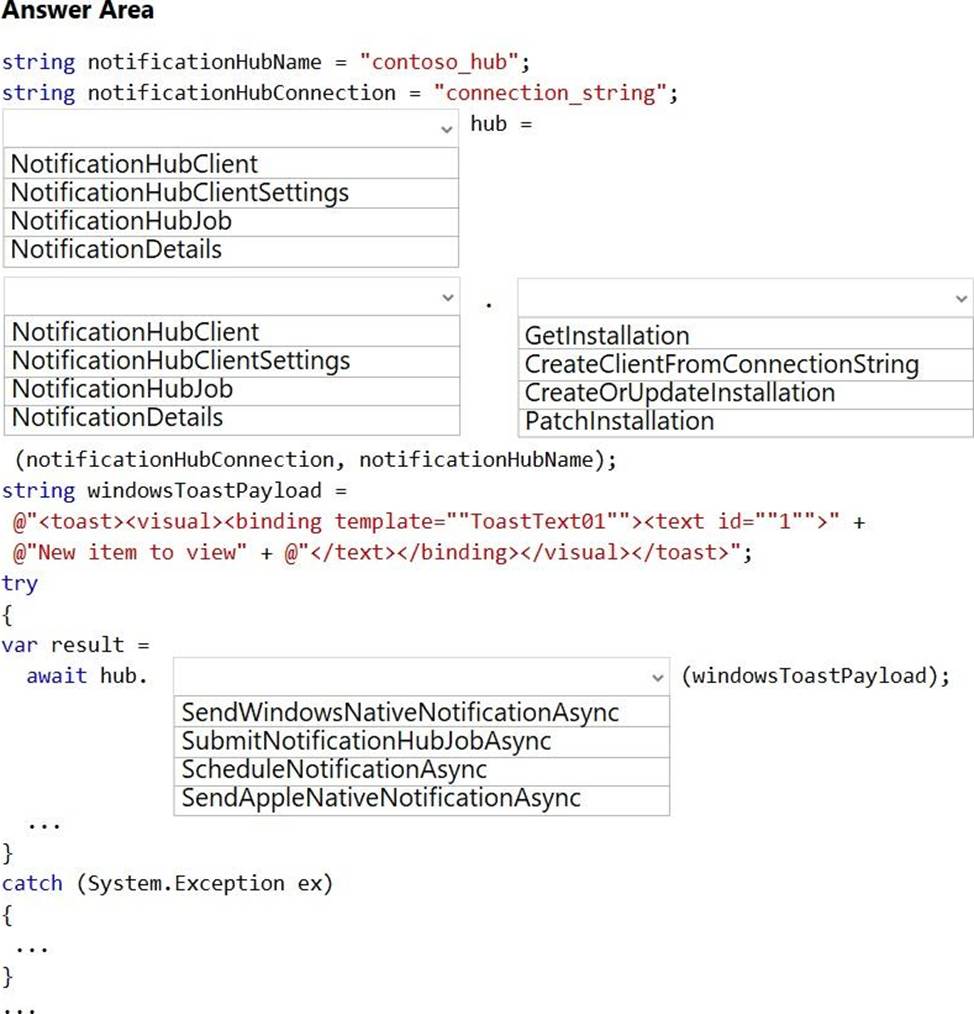

Explanation:
Box 1: NotificationHubClient
Box 2: NotificationHubClient
Box 3: CreateClientFromConnectionString
// Initialize the Notification Hub
NotificationHubClient hub =
NotificationHubClient.CreateClientFromConnectionString(listenConnString, hubName);
Box 4: SendWindowsNativeNotificationAsync
Send the push notification.
var result = await hub.SendWindowsNativeNotificationAsync(windowsToastPayload);
Reference: https://docs.microsoft.com/en-us/azure/notification-hubs/notification-hubs-push-notification-registration-management
https://github.com/MicrosoftDocs/azure-docs/blob/master/articles/app-service-mobile/app-service-mobile-windows-store-dotnet-get-started-push.md
HOTSPOT
You are implementing a software as a service (SaaS) ASP.NET Core web service that will run as an
Azure Web App. The web service will use an on-premises SQL Server database for storage. The web service also includes a WebJob that processes data updates.
Four customers will use the web service.
• Each instance of the WebJob processes data for a single customer and must run as a singleton instance.
• Each deployment must be tested by using deployment slots prior to serving production data.
• Azure costs must be minimized.
• Azure resources must be located in an isolated network.
You need to configure the App Service plan for the Web App.
How should you configure the App Service plan? To answer, select the appropriate settings in the answer area. NOTE: Each correct selection is worth one point.
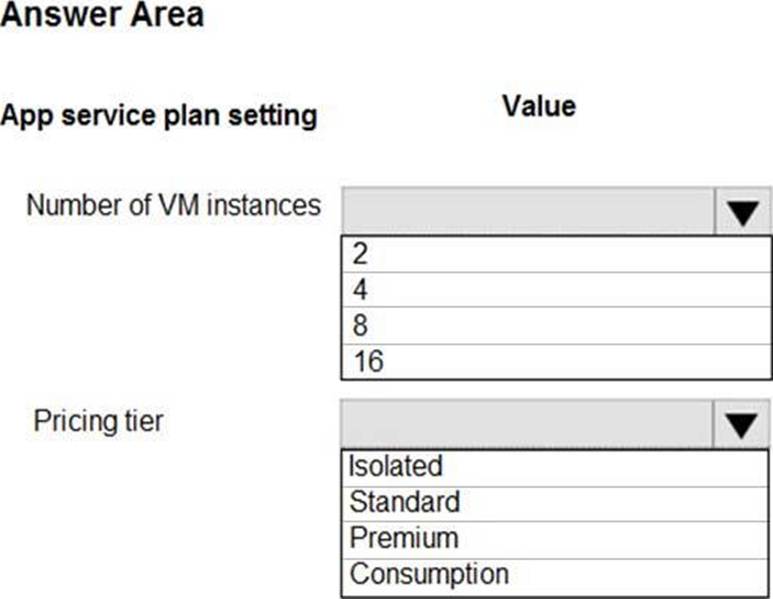
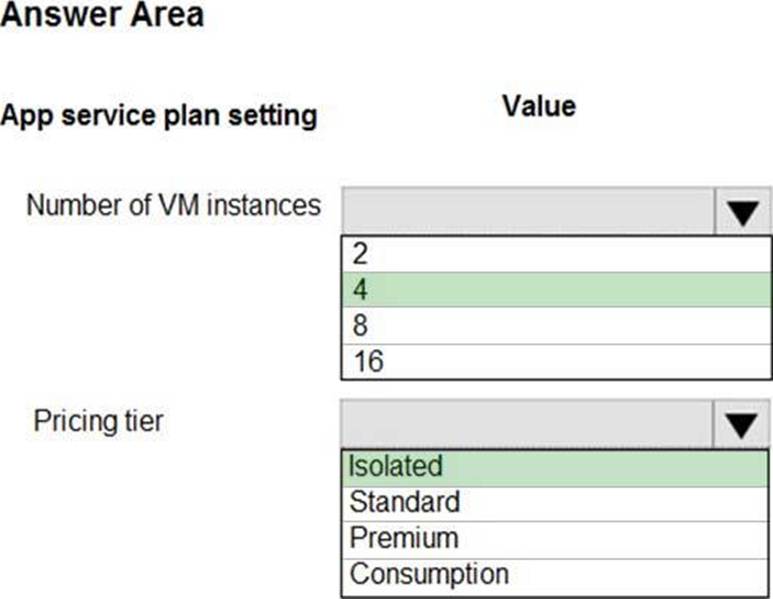
Explanation:
Number of VM instances: 4
You are not charged extra for deployment slots.
Pricing tier: Isolated
The App Service Environment (ASE) is a powerful feature offering of the Azure App Service that gives network isolation and improved scale capabilities. It is essentially a deployment of the Azure App Service into a subnet of a customer’s Azure Virtual Network (VNet).
Reference: https://azure.microsoft.com/sv-se/blog/announcing-app-service-isolated-more-power-scale-and-ease-of-use/
DRAG DROP
Contoso, Ltd. provides an API to customers by using Azure API Management (APIM). The API authorizes users with a JWT token.
You must implement response caching for the APIM gateway. The caching mechanism must detect the user ID of the client that accesses data for a given location and cache the response for that user ID.
You need to add the following policies to the policies file:
• a set-variable policy to store the detected user identity
• a cache-lookup-value policy
• a cache-store-value policy
• a find-and-replace policy to update the response body with the user profile information
To which policy section should you add the policies? To answer, drag the appropriate sections to the correct policies. Each section may be used once, more than once, or not at all. You may need to drag the split bar between panes or scroll to view content. NOTE: Each correct selection is worth one point
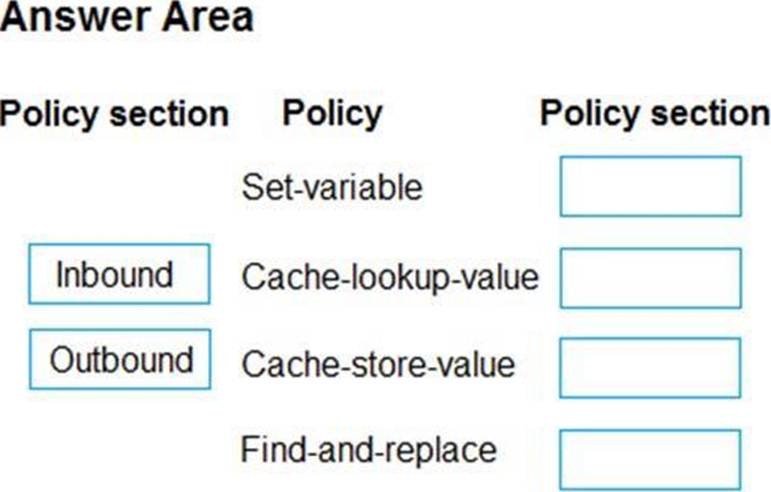
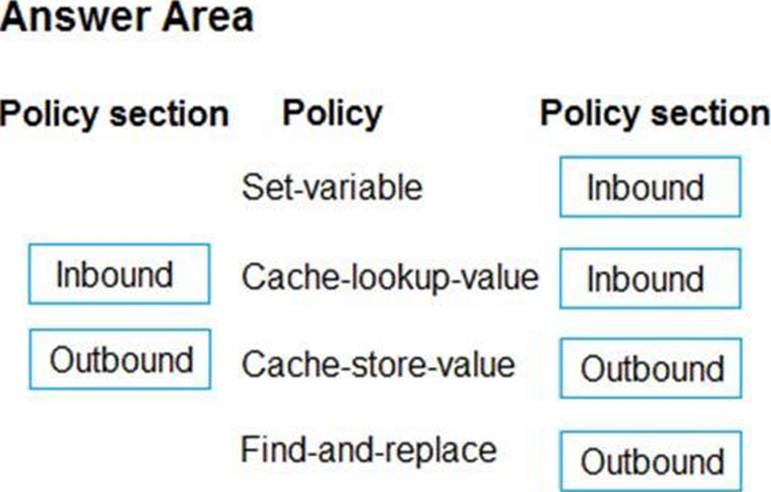
Explanation:
Box 1: Inbound.
A set-variable policy to store the detected user identity.
Example:
<policies>
<inbound>
<!– How you determine user identity is application dependent –>
<set-variable
name="enduserid"
value="@(context.Request.Headers.GetValueOrDefault("Authorization","").Split(‘ ‘)[1].AsJwt()?.Subject)" />
Box 2: Inbound
A cache-lookup-value policy
Example:
<inbound>
<base />
<cache-lookup vary-by-developer="true | false" vary-by-developer-groups="true | false" downstream-caching-type="none | private | public" must-revalidate="true | false">
<vary-by-query-parameter>parameter name</vary-by-query-parameter> <!– optional, can repeated several times –>
</cache-lookup>
</inbound>
Box 3: Outbound
A cache-store-value policy.
Example:
<outbound>
<base />
<cache-store duration="3600" />
</outbound>
Box 4: Outbound
A find-and-replace policy to update the response body with the user profile information.
Example:
<outbound>
<!– Update response body with user profile–>
<find-and-replace
from=’"$userprofile$"’
to="@((string)context.Variables["userprofile"])" />
<base />
</outbound>
Reference:
https://docs.microsoft.com/en-us/azure/api-management/api-management-caching-policies
https://docs.microsoft.com/en-us/azure/api-management/api-management-sample-cache-by-key
DRAG DROP
Contoso, Ltd. provides an API to customers by using Azure API Management (APIM). The API authorizes users with a JWT token.
You must implement response caching for the APIM gateway. The caching mechanism must detect the user ID of the client that accesses data for a given location and cache the response for that user ID.
You need to add the following policies to the policies file:
• a set-variable policy to store the detected user identity
• a cache-lookup-value policy
• a cache-store-value policy
• a find-and-replace policy to update the response body with the user profile information
To which policy section should you add the policies? To answer, drag the appropriate sections to the correct policies. Each section may be used once, more than once, or not at all. You may need to drag the split bar between panes or scroll to view content. NOTE: Each correct selection is worth one point


Explanation:
Box 1: Inbound.
A set-variable policy to store the detected user identity.
Example:
<policies>
<inbound>
<!– How you determine user identity is application dependent –>
<set-variable
name="enduserid"
value="@(context.Request.Headers.GetValueOrDefault("Authorization","").Split(‘ ‘)[1].AsJwt()?.Subject)" />
Box 2: Inbound
A cache-lookup-value policy
Example:
<inbound>
<base />
<cache-lookup vary-by-developer="true | false" vary-by-developer-groups="true | false" downstream-caching-type="none | private | public" must-revalidate="true | false">
<vary-by-query-parameter>parameter name</vary-by-query-parameter> <!– optional, can repeated several times –>
</cache-lookup>
</inbound>
Box 3: Outbound
A cache-store-value policy.
Example:
<outbound>
<base />
<cache-store duration="3600" />
</outbound>
Box 4: Outbound
A find-and-replace policy to update the response body with the user profile information.
Example:
<outbound>
<!– Update response body with user profile–>
<find-and-replace
from=’"$userprofile$"’
to="@((string)context.Variables["userprofile"])" />
<base />
</outbound>
Reference:
https://docs.microsoft.com/en-us/azure/api-management/api-management-caching-policies
https://docs.microsoft.com/en-us/azure/api-management/api-management-sample-cache-by-key
You are creating a hazard notification system that has a single signaling server which triggers audio and visual alarms to start and stop.
You implement Azure Service Bus to publish alarms. Each alarm controller uses Azure Service Bus to receive alarm signals as part of a transaction. Alarm events must be recorded for audit purposes. Each transaction record must include information about the alarm type that was activated.
You need to implement a reply trail auditing solution.
Which two actions should you perform? Each correct answer presents part of the solution. NOTE: Each correct selection is worth one point.
- A . Assign the value of the hazard message SessionID property to the ReplyToSessionId property.
- B . Assign the value of the hazard message MessageId property to the DevileryCount property.
- C . Assign the value of the hazard message SessionID property to the SequenceNumber property.
- D . Assign the value of the hazard message MessageId property to the CorrelationId property.
- E . Assign the value of the hazard message SequenceNumber property to the DeliveryCount property.
- F . Assign the value of the hazard message MessageId property to the SequenceNumber property.
A, C
Explanation:
Reference: https://docs.microsoft.com/en-us/azure/service-bus-messaging/service-bus-messages-payloads
An organization hosts web apps in Azure. The organization uses Azure Monitor You discover that configuration changes were made to some of the web apps. You need to identify the configuration changes.
Which Azure Monitor log should you review?
- A . AppServiceEnvironmentPlatformLogs
- B . AppServiceApplogs
- C . AppServiceAuditLogs
- D . AppServiceConsoteLogs
HOTSPOT
You have an app that stores player scores for an online game. The app stores data in Azure tables using a class named PlayerScore as the table entity. The table is populated with 100,000 records.
You are reviewing the following section of code that is intended to retrieve 20 records where the player score exceeds 15,000. (Line numbers are included for reference only.)
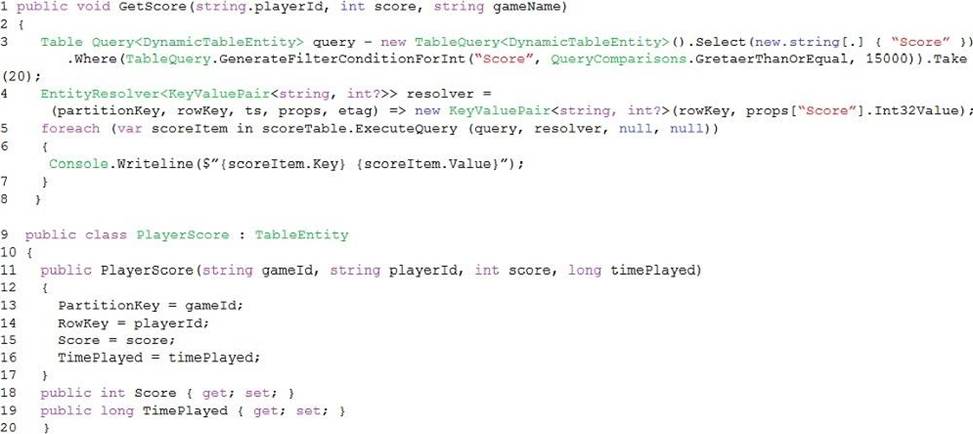
You have the following code. (Line numbers are included for reference only.)
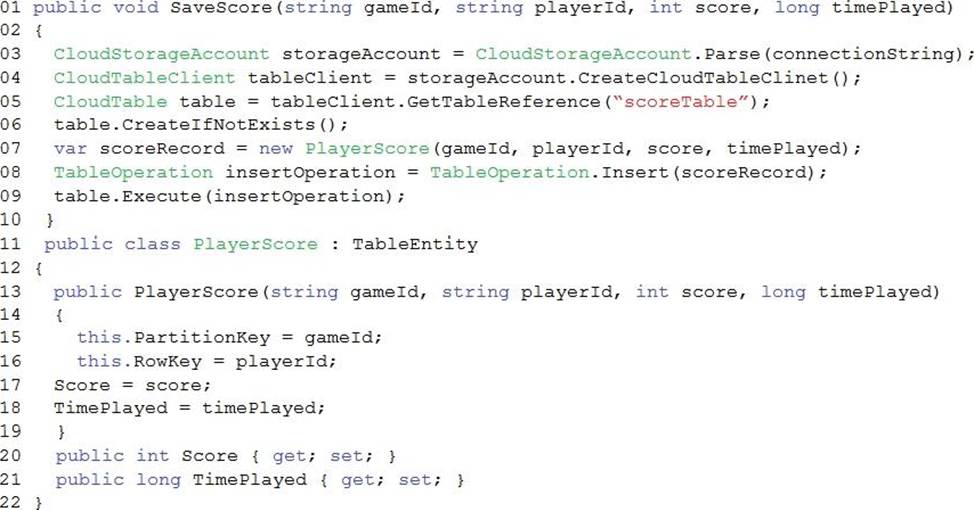
You store customer information in an Azure Cosmos database.
The following data already exists in the database:

You develop the following code. (Line numbers are included for reference only.)

For each of the following statements, select Yes if the statement is true. Otherwise, select No. NOTE: Each correct selection is worth one point.
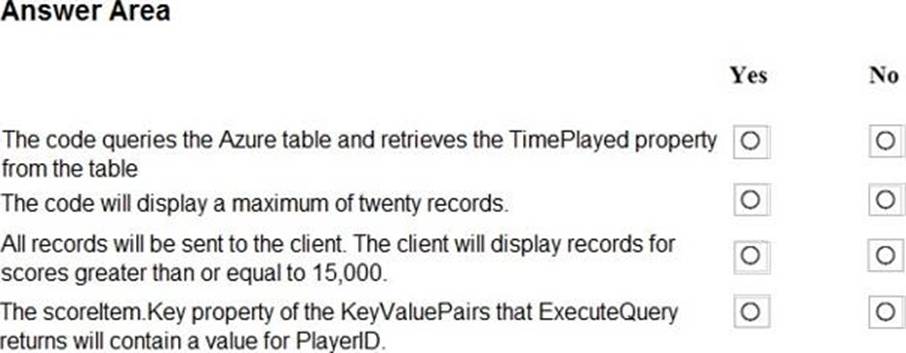
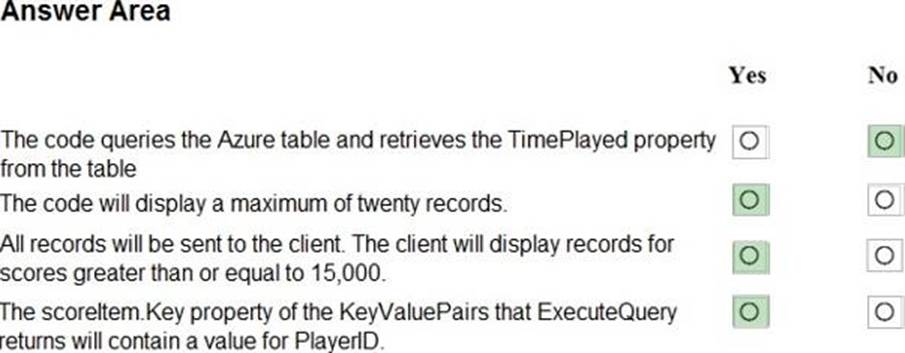
Explanation:
Box 1: No
Box 2: Yes
The TableQuery.Take method defines the upper bound for the number of entities the query returns.
Example:
query.Take(10);
Box 3: Yes
Box 4: Yes
Reference: https://www.vkinfotek.com/azureqa/how-do-i-query-azure-table-storage-using-tablequery-class.html
Note: This question is part of a series of questions that present the same scenario. Each question in the series contains a unique solution that might meet the stated goals. Some question sets might have more than one correct solution, while others might not have a correct solution.
After you answer a question in this question, you will NOT be able to return to it. As a result, these questions will not appear in the review screen.
You are developing a website that will run as an Azure Web App. Users will authenticate by using their Azure Active Directory (Azure AD) credentials.
You plan to assign users one of the following permission levels for the website: admin, normal, and reader. A user’s Azure AD group membership must be used to determine the permission level. You need to configure authorization.
Solution: Configure the Azure Web App for the website to allow only authenticated requests and require Azure AD log on.
Does the solution meet the goal?
- A . Yes
- B . No
B
Explanation:
Instead in the Azure AD application’s manifest, set value of the groupMembershipClaims option to All.
Reference: https://blogs.msdn.microsoft.com/waws/2017/03/13/azure-app-service-authentication-aad-groups/
